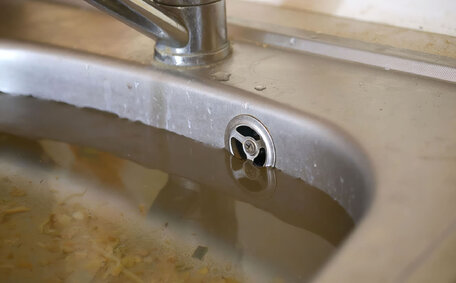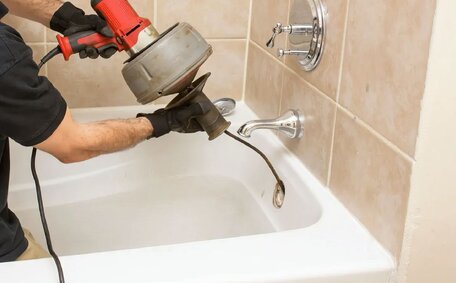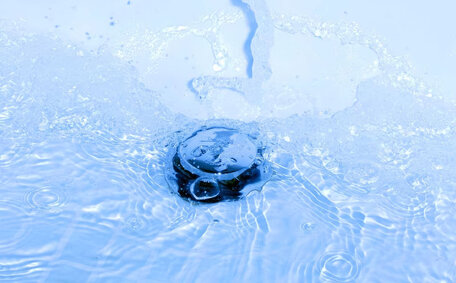Shut Off the Water Supply
Immediately upon detecting a burst pipe in your home, it’s critical to shut off the main water supply. This quick action helps limit the extent of water damage. Here’s how to respond right away to a pipe burst:
Typically, your water shutoff valve is located where the main lines enter the house, likely near the front entrance, or in basement areas. It’s beneficial to understand how to use this valve, which usually looks like a lever or tap, before any plumbing emergencies arise.
- To stop the water flow, turn the valve clockwise until it stops. This fully closes the valve, terminating the action and ensuring an efficient way to shut off your water to prevent complications in any further pipes that could damage your home. Sometimes, you may also need to shut off your stiff valve using apparatus such as spanners or pliers to ensure it’s completely closed.
- If an internal shutoff valve isn’t available, resort to the street-level main control. Find the water meter housing, open it, and operate the external Stop valve inside to cease the water flow, thus averting additional damage.
- Confirm the shutoff was successful by ensuring no water exits from the faucets. If water continues to flow, it implies the valve hasn’t been fully closed, which could lead to further issues, such as pipes freezing and bursting.
Upon spotting a damaged pipe, quickly enlist the services of a professional plumber for repair. Maintaining the water supply off safeguards your entire plumbing system from additional damage.
Locate the Source of the Leak
After you switch off main water access, call your plumber to identify the origin of the disruption to mitigate extra harm to your water system. This enables the plumber to quickly fix the fault and service the affected pipe. Here are some tips for finding the source of the leak:
- Look for overt signs of water leaks like damp carpets or drooping ceilings, often a result of pipe bursts. These are important clues to determine the rupture’s location.
- Examine common piping areas; under sinks, behind appliances, and within structural elements like floors or walls. Pipes in colder and less circulated spaces are more prone to bursting.
- Examine all visible plumbing for signs of burst or fractures where water might escape.
- Observe and follow any water drips or pools on floors and walls to their source.
- Crawl under the house or check the basement to locate your burst water pipe if suspected to be inside a wall, under the floor, or within the foundation.
To assess damage, avoid attempting to remove building materials like drywall; let a professional handle it.
- Note any water damage or evidence of burst water pipes to accurately convey the situation’s severity to the plumber. This strategic approach gives them an advance in diagnosing and servicing the water supply your drain system depends on.
Remove Any Valuables From the Affected Area
If your burst pipe becomes evident, it’s crucial to act quickly to protect your belongings from water damage. Here are some tips on removing valuables from the affected area:
- Prioritise safeguarding irreplaceable items like photo albums and documents, to momentarily pivot your focus from agonising over what to do next. Carefully move these items into your chosen dry location.
- Be extremely cautious when moving electronics near water. Unplug TVs, computers, stereos etc and relocate them before they get wet.
- Swiftly move large furniture from the wet area after turning off your home’s water. This is key to avoiding irreversible damage or spoiling your home’s interior due to burst pipes.
- Relocate fragile valuables like china, antiques or artwork to prevent them being knocked over or ruined.
- Wear rubber boots and gloves for protection against electric shocks when handling wet areas.
- Act quickly and methodically when removing items to minimise water damage losses.
- Don’t risk injury by moving large or heavy objects alone. Ask others to assist if needed.
Once your valuables are secure, be sure to photograph the affected areas for insurance documentation.
Taking decisive steps can take precedence when a pipe bursts unexpectedly to safeguard your irreplaceable possessions. Taking prompt action can mitigate the chaos from damage burst pipes can cause.
Enlisting a professional plumber is essential for addressing burst pipe issues. At Hornsby Plumbing, we’re proficient in:
- Accurately locate the site of the burst and assess the necessary repairs.
- Replace broken sections of pipe and any water-damaged areas.
- Restore proper water flow and pressure.
- Check your entire plumbing system for potential water leaks that may have caused the burst.
- Provide emergency leak detection services.
Our skilled plumbers adeptly handle burst pipe repairs, considering your entire hot water system to apply advanced, durable repair techniques. We can also assist with your insurance claim and water mitigation services.
Don’t risk further damage by delaying - call the team at Hornsby Plumbing on 1300 349 338 For expert repair of a burst pipe at any hour, Hornsby is covered.
Accurately locate the site of the burst and assess the necessary repairs.Replace broken sections of pipe and any water-damaged areas.Restore proper water flow and pressure.Document the Damage for Insurance
Rest assured, when you find burst pipe damage, it’s critical to thoroughly document it for insurance purposes, where an emergency plumber can offer assistance. Here are some tips:
- Photograph every area impacted, particularly floors, walls, furnishing and personal items. These visuals demonstrate the scale of water damage caused by burst pipes to your insurance provider.
- Make detailed notes describing each area of water damage, a vital step to do when you find burst pipe issues. Include locations, a damage description, and list affected items.
- Note the date and time you discovered the leak. This helps establish a timeframe.
- Maintain samples of materials like carpet from the affected area to illustrate the extent of what to do when you find burst pipe damage.
- Track and record any expenses you incur addressing the burst, like accommodation costs.
- Hang onto receipts for repair supplies, services, or replacement items.
- Our team at Hornsby Plumbing can also inspect and provide documentation to support your claim.
Documenting the damage meticulously, for insurance purposes only, provides clear proof and streamlines the claims procedure. Contact us today if you need assistance.
File an Insurance Claim
After repairing the burst pipe, filing an insurance claim for any water damage is essential.
Promptly reach out to your insurance provider to initiate the claims process for a burst pipe. Present all relevant documentation, such as photographs, receipts for repairs, and an inventory of damaged or lost possessions.
Acquainting yourself with your coverage in advance paves the way to confidently know what to do when dealing with burst pipes. It’s crucial to review your documentation - having robust records bolsters your case for claimed damages.
Most home insurance policies cover sudden water damage events like this, but the extent of coverage can vary. If significant losses occurred, you may be advised to file a detailed claim listing all damaged items.
At Hornsby Plumbing, our team can provide documentation like repair invoices and damage assessments to support your insurance claim process. Don’t hesitate to get in touch if you need assistance filing a claim for burst pipe damage.
Prevent Mold and Mildew Growth
Once the burst pipe is repaired, it’s important to prevent mould and mildew growth in any water damaged areas. Considering mould and mildew can provoke serious health impediments, it’s important to act without delay. Here are some tips:
- Open windows and doors to increase air circulation and ventilation.
- Use fans, dehumidifiers, and heating to manage the aftermath when pipe bursts, ensuring drying is efficient and thorough in affected areas.
- Discard porous items that cannot be dried quickly like carpets and upholstery.
- Scrub surfaces with a mix of detergent and bleach to kill mould spores.
- Consider using a professional mould remediation service for large affected areas.
- After drying out, repaint the walls and take steps to thaw your pipes if they are frozen, using mould-resistant paint for the walls.
- Substitute the insulation in moist walls to avert future mould, which can invade your living spaces stealthily.
Taking quick action to dry out areas and kill mould prevents it taking hold in your home. Contact Hornsby Plumbing if you need professional help with mould remediation after handling burst pipe repairs.
Make Temporary Repairs
While waiting for a professional plumber to arrive, there are some temporary fixes you can attempt to slow or stop a small leak.
For pinhole leaks or cracks in pipes, try wrapping the area tightly with waterproof tape. You can also attempt to patch larger holes with an epoxy putty designed for plumbing repairs. Position a bucket or pan under dripping pipes to catch water. For minor leaks, wrap the area with waterproof tape as a temporary fix. Focus on limiting damage until a qualified plumber can permanently fix the issue.
Clean and Dry Affected Areas
After repairing the breach and halting the flow, it’s essential to diligently dry any damp zones due to the off water supply your home experienced. Remaining moisture can lead to secondary damage like warped floors, peeling paint and mould growth.
Use old towels to absorb puddles and standing water To mitigate water damage, there are steps you can take when pipe bursts occur. For carpets, lay down several layers of towels and stand on them to absorb as much water as possible. A wet/dry shop vacuum is also handy for removing water from floors and upholstery during repair burst pipe situations.
Open windows and doors and place fans strategically for ventilation and drying in the affected areas. It’s important to act swiftly when you discover pipe bursts; promptly shut off the water supply and remove wet items to reduce chaos.
Dehumidifiers can help dry the air.
For water damage-control, clean up walls, floors, cabinets, and other surfaces with a disinfectant solution. Mild bleach or vinegar mixed with water works well. Be thorough - leaving moisture behind can enable mould and mildew growth later.
Continue using fans and dehumidifiers for days after the water catastrophe to assure thorough drying, as dampness causes burst pipes. Have a water supply shut off inspection by your plumber for any remaining dampness that could cause structural issues over time. Thorough drying prevents further damage and potential health hazards.
Take Steps to Prevent Future Pipe Bursts
Inspect pipes annually for signs of corrosion and have worn sections replaced. Follow these tips and contact Hornsby Plumbing for professional plumbing maintenance services to help safeguard your plumbing from future burst pipe disasters.
Insulating exposed pipes reduces the risk of weather-related bursts. Consider installing burst-resistant PEX piping during renovations as a long-term protective measure.
Insulate Pipes
Insulating your pipes is a critical preventative measure against bursts during cold spells, especially for those exposed to the elements.
For preventing frozen pipe issues in the Hornsby climate, flexible foam tubing is a good option. Foam pipe insulation is easy to install, fits tightly over pipes, and provides excellent insulation against both cold and heat. Look for insulation with an adhesive strip to secure it snugly to pipes.
Prioritise insulating pipes in unheated areas like crawl spaces, attics, garages and exterior walls. Also insulate pipes close to draughty windows or doors to help prevent pipes from freezing. Measure your pipe diameter and cut the flexible foam tubing to fit the length of each pipe section.
Seal seams and connections with waterproof tape to prevent condensation and take action against pipes freezing under the insulation. Check insulation annually and repair any cracks or gaps right away. Properly insulating exposed pipes is a simple, low cost way to protect your plumbing from freezing weather and help prevent disastrous burst pipes.
For professional pipe insulation services in the Hornsby area, contact the licenced team at Hornsby Plumbing on 1300 349 338.
Maintain Consistent Temperature
Maintain a consistent temperature in your home to prevent the risk of burst pipes during the winter season. During cold snaps, you can take action by maintaining the thermostat at 55F (13C) or higher, even while asleep or away. Seal any draughty windows, doors or vents that let cold air inside. Open cabinet doors for warm air to support pipe repair by circulating around pipes located on external walls.
Don’t turn the heating off completely. Consider installing a programmable thermostat to automate temperature regulation. Insulate ceilings and walls to maintain warmth in rooms where water pipes are situated, reducing the risk of burst due to cold temperatures.
Avoid drastically lowering the temperature at night or when leaving your home by letting it drop more than 5-10 degrees. To shield your household water system, permit a minor stream of water to run overnight from the taps most distant from the main pipelines. Make sure to open taps to drain and allow hot water to circulate into uninsulated areas like basements, to safeguard pipes in these susceptible spaces.
Avoid sudden temperature drops to protect your pipes from freezing and bursting.
Maintaining a stable, moderate temperature throughout your home is one of the most effective ways to prevent burst pipes during freezing weather. Contact our team at Hornsby Plumbing on 1300 349 338 if you need help regulating your home’s temperature.
At Hornsby Plumbing, our licenced plumbers can conduct a thorough inspection of your home’s water lines, pipes, fittings and water heater to check for leaks, corrosion, blockages or other issues.
During the inspection, the plumber will:
- Inspect all visible plumbing such as pipes, joints and fixtures for wear and tear or indications of dripping and corrosion.
- Measure water pressure and flow in taps and showers to ensure they are within safe and functional parameters.
- Examine toilet tanks and their components for any leaks or operational issues.
- Check pipe connections at water heater and under sinks for drips or loose fittings.
- Assess condition of your main water supply shutoff valve.
- Look for staining or dampness on walls, floors and ceilings indicating hidden leaks.
Regular inspections allow plumbers to spot potential problems early and recommend repairs before a pipe bursts or major damage occurs. Annual checks also give homeowners peace of mind. Contact the team at Hornsby Plumbing on 1300 349 338 to schedule your plumbing inspection today.
At Hornsby Plumbing, our licenced plumbers can conduct a thorough inspection of your home’s water lines, pipes, fittings wear and tear or indications of dripping and corrosion.






